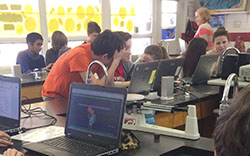This lesson is for : Grade 8:
Summary
Station rotations are an integral part of all the units I teach. They are a way for me to express my creativity and a way for students to review material, preview material and practice our current topics. I try to create my stations with the students in mind; specifically their learning styles. I try to make sure all of the students are able to find a way to connect to the material being covered. Each station is labeled with the learning style that is supported by the activity.
Collaboration plays a key role in this lesson and the use of multiple Google Apps made team collaboration possible. Students use current event sites, government funded sites and other sources of information online to conduct research.
Each station provides a different topic for student investigation. The topics include Watersheds, Groundwater Contamination, How Water Flows Underground, Comparing and Contrasting River Systems, The Water Cycle, and Searching Mars for Proof of Rivers.
TIPC Ratings
Research & Information Fluency
Rating: Developing – Explanation: In the watershed station, students were required to find answers to teacher posed questions. They used research techniques previously modeled and implemented in class to discover and present accurate answers. Students continued their research by creating their own model watershed and observing patterns of the flow of water.
Communication & Collaboration
Rating: Ideal – Explanation: Group work and stations are a technique used often in our class. Students are accustomed to establishing norms and roles without teacher guidance. Once the students gathered into their self selected groups, they quickly determined which individual would be responsible for copying and sharing all team documents and who would facilitate time management. Groups usually select the same team members because they know they work well together and are already aware of each other’s strengths and weaknesses.
Students were able to participate in the collaborative effort of their team even if they were absent. Two particular students were absent due to pre-planned medical appointments. They were still included by their team and were able to contribute to the assignment from their home after their appointments and during the weekend. When the groups reconvened on the following Monday, they reviewed their contributions with the team and continued to work.
Critical Thinking & Problem Solving
Rating: Ideal – Explanation: Students were posed with several authentic problems to solve. In the groundwater contamination station, students used the knowledge of groundwater pollutants and water flow to determine the best locations for monitoring wells. Based on their initial selection of monitoring wells (from the spreadsheet map), the teacher provided data which the teams analyzed to determine the next coordinates for placing the monitoring wells to best monitor home fresh water wells for contamination.
In the Nile v Amazon station, students used Google Earth to investigate the terrain and identify land and river features. Images were collected, edited in Google Draw and pasted onto their group document. Teams identified characteristics and analyzed the images. They determined specific land and river features and labeled them in their inserted google drawing.
In the Take Me to Mars station, students had to find evidence of past rivers on Mars and compare them to the information that they already know about how rivers form on the Earth. Students snipped images from Google Mars to indicate where they believe water/rivers might once have existed. They had to analyze the picture and explain what the terrain of the land might have been like (based on similar patterns on Earth) in order for the river to develop and change.
Creativity & Innovation
Rating: Ideal – Explanation: In the Tell Me a Story station, students created original stories about a water drop traveling through the water cycle include groundwater as part of the story. Students used their knowledge of the water cycle, ground water and their middle school creativity to produce elaborate adventures for their water droplet. They added characteristics to their drop that fit with some aspect of water. Some groups exceeded expectations of this creative assignment by building a digital character to accompany their story.





